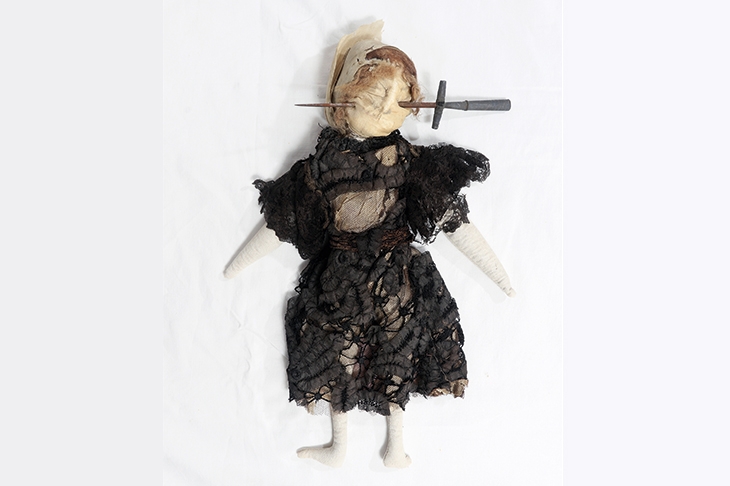Just in front of me, visiting Spellbound at the Ashmolean last week, was a very rational boy of about seven and his proud mother.
‘I don’t believe in magic, witches or Father Christmas,’ he announced to the girl presiding over Room One.
‘Perhaps you’re spiritual but not religious,’ said the girl.
The rational boy gave her the look she deserved.
In that first room pride of place is given to a squat little silvered bottle with a hand-written label: ‘Obtained in 1915 from an old lady living in Hove, Sussex. She remarked: “and they do say there be a witch in it, and if you let un out there’ll be a peck o’ trouble”.’
The witch bottle usually lives in the Pitt Rivers down the road, where it’s a star turn, and it’s clear why. The little bottle has menace, charm and it conjures a crowd: the old lady, keeper of the witch; the mysterious ‘they’ who caution her; the spectral witch inside, plotting her escape. And it made the rational boy smile — which, as it turned out, was quite a feat.
Behind the bottle, in that first room, there is also a modern-looking ladder attached to the wall. We’re conducting an experiment, said the girl attendant. Do you dare go under it? And I’m afraid it’s at this early stage that Spellbound loses its magic.
There are interesting objects: manuscripts picturing the earth at the centre of a cosmos teeming with demons; 15th-century ‘zodiac man’, from the Astronomical Calendar by Nicholas of Lynn, over from the Bodleian. A third room contains the weird witch-like charms found in medieval homes: a toad run through with thorns, a ‘witch-ladder’ tied with feathers. But everywhere, as a refrain, this message: aren’t we all a bit superstitious? Are you sure you’re not irrational too?
But, of course we are. That’s what’s so confusing. Do the curators really imagine that any 21st-century visitor (save the boy) thinks themselves purely scientific? We’re almost as batty as our forbears — more so for having less excuse. We read star signs, we go to church, we spend thousands on face creams that promise to reverse ageing. We fall in love with strangers, we smoke, we believe in ghosts. If Spellbound is underpinned by the idea that it’ll be fun and provocative for visitors to realise that they too are irrational, then it’s underpinned by a mistake.
There are other missteps too. Sometimes we’re encouraged to enter the dark ages; feel the medieval fear. The catalogue seems aimed at Potter fans: all feathers, spells and gold. The ancient artefacts are presented as evidence of a world thick with violence and voodoo. Then a label will explain, in a sheepish way, that there may well be a more rational explanation.
The heart stuck with pins wasn’t intended to harm an enemy, but to ward off evil; the ‘witches ladder’ (a string tied with feathers) might well have just been a ‘sewel used for driving deer’. I’d like to have known what exactly a ‘sewel’ was and how it worked. It’s neither spooky enough nor scholarly enough.
Perhaps the curators can’t be blamed for the fact that the objects that sound witchiest on paper — a mummified cat or a shrivelled heart, say — look so sad out of context. Because they’re not beautiful or beautifully made, they lack power. By contrast, as you walk back out of the Ashmolean you pass objects with real presence: an ancient pilgrimage cross, worn from touching; the magnificent hand-sewn cloak of a native American shaman.
Other decisions seem more baffling. If the architects of Spellbound wanted us to enter into the medieval mind, why commission a set of installations by contemporary artists? There’s a pair of embarrassing model dragons, a fish skeleton covered in droplets of plastic — but why?
In one little room a red laser zips about making scribbles on the wall. ‘In Vitro’, it’s called, by Katharine Dowson. The rational child and I walked in together and then out together in the same fluid movement. We ended up side by side in front of a wall of padlocks — a selection of the thousands cut from Leeds Centenary bridge. See? says the exhibition again. We’re still at it, still making love charms in the 21st century. But are we? Did the lovers who left padlocks on the bridge really think they were casting a spell, or were they just having a moment, doing something soppy?
‘The closed padlock represents everlasting love,’ said the child’s mother appearing beside us. ‘Well, they’re all broken now aren’t they?’ observed the boy.







Comments